Earlier on Monday Spain's Supreme Court sentenced nine Catalan leaders to prison terms ranging from nine to 13 years for sedition and misuse of public funds for their role in a failed 2017 independence bid.
Within minutes of the ruling demonstrators had poured onto the streets of the Catalan capital, waving flags and blocking traffic over the conviction of the separatist leaders who organised a 2017 referendum banned by Madrid.
“We have to mobilise and stick up for them … in a way that has an impact, closing airports, stations, but always avoiding violence,” Guich said. “Or at least, it won't be us that provokes it.”
Following the verdict demonstrations got underway in Barcelona, including one on the city's main thoroughfare the Via Laietana with protesters demanding the prisoners release.
VIDEO: Tens of thousands of students singing the Catalan anthem are moving to Plaça Catalunya of Barcelona.pic.twitter.com/jSKUTsYnh3
— Josep Goded (@josepgoded) October 14, 2019
Amazing to see Barcelona almost grind to a halt in the city centre due to these protests #CatalanProtests pic.twitter.com/68n5vhdfNu
— Join my FFL fudhv3 (@MikeDingDong) October 14, 2019
Crowds also gathered at Plaça San Jaume, the seat of the Catalan government in Barcelona. There were also reports of protesters putting barricades across train tracks and roads.
“I feel fury and a sense of powerlessness,” said Joan Guich, a 19-year-old student protesting in Barcelona after Spain's Supreme Court jailed nine Catalan leaders jailed over a failed independence bid.
“They have been convicted for an ideology which I agree with.”
“People protest holding placards reading “Spanish State does not dialog, it sentences” in Barcelona on October 14, 2019, after Spain's Supreme Court sentenced nine Catalan leaders to prison terms ranging from nine to 13 years” (Independent, 14/10/19). pic.twitter.com/uHWJyKHTzA
— Henry Ettinghausen (@MareDentano) October 14, 2019
Democratic Tsunami, a group advocating more active forms of civil disobedience, sent a message to its 150,000 members urging them to march on Barcelona airport, 15km from the city centre.
“The time has come to make our voice felt around the world. The goal: stop the activity of Barcelona's airport,” it said.
Video images from the airport showed riot police clashing with protesters (see below) with reports of tear gas being fired inside the terminal.
Spanish occupation forces start to charge at Barcelona airport against peaceful demonstrators (& press!) who protest against 100-yrs-jail of 9 #Catalonia political leaders for organizing 2017 independence referendum#SpainIsAFascistState#Standup4Cataloniapic.twitter.com/LMBaTvO7mW
— [ David d'Ent.?#JoSócCDR ] (@denterd) October 14, 2019
Hundreds of passengers were caught up in the chaos, with many forced to walk along the highway with their luggage.
Metro and train access was briefly blocked and there were reports of numerous flights being cancelled.
? | Thousands of protestors at Barcelona airport are met with a cordon of police and at least 15 police riot vans. Some flights have already been cancelled as a result of the disruptions pic.twitter.com/DIFxxX04i6
— Catalan News (@catalannews) October 14, 2019
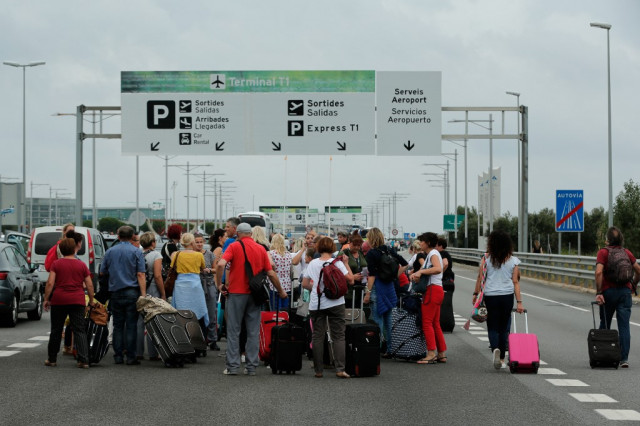 Passengers walk on the highway towards El Prat airport in Barcelona on October 14, 2019 as thousands of angry protesters took to the streets. AFP
Passengers walk on the highway towards El Prat airport in Barcelona on October 14, 2019 as thousands of angry protesters took to the streets. AFP
Marching on #Barcelona airport in response to the sentences imposed on the #CatalanPoliticalPrisoners. pic.twitter.com/dXLbZn6gLP
— John Clarke (@JohnOCAP) October 14, 2019
Thousands of people arriving at Barcelona airport in protest at the sentences of 9-13 years today given to Catalan political prisoners https://t.co/qpNWz7TIiT
— Jon Davison (@jondavison) October 14, 2019
BREAKING/VIDEO: First clashes in one of the accesses of Barcelona airport. pic.twitter.com/MPMM8SAkXM
— Josep Goded (@josepgoded) October 14, 2019
BREAKING/VIDEO: Police fires tear gas against demonstrators in one of the accesses to the Barcelona airport.pic.twitter.com/ZSnCd5RFiY
— Josep Goded (@josepgoded) October 14, 2019
Not looking good at #BarcelonaAirport right now… #ElPrat https://t.co/5y8U4Miqhj
— Mark E Greene (@MarkEGreene) October 14, 2019
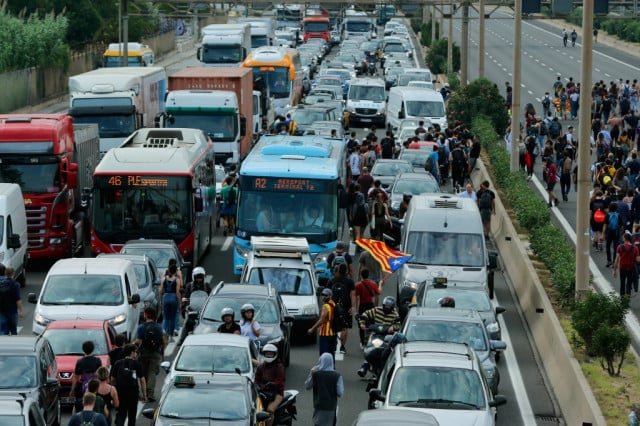 AFP
AFP
Thousands of people arriving at Barcelona airport in protest at the sentences of 9-13 years today given to Catalan political prisoners https://t.co/qpNWz7TIiT
— Jon Davison (@jondavison) October 14, 2019
Barcelona airport blocked, all terminals obstructed, as #TsunamiDemocratic protesters also block highways outside, fighting to reassert their autonomy against the Spanish state on the heels of the #CatalanTrial pic.twitter.com/ntRzlJwQEy
— Vitalist International (@VitalistInt) October 14, 2019
 AFP
AFP
#Barcelona #Airport pic.twitter.com/lvNtowN9H5
— Eoin Grealis (@egrealis) October 14, 2019
Pro-independence activists heading to Barcelona's airport are trying to occupy it in protest against the ruling by the Spanish Supreme Court, which sentenced Catalan politicians and social leaders to jail. Several highways and train stations in #Catalonia are also occupied. https://t.co/W5TEIqIQBB
— Marta Ter (@marta_ter) October 14, 2019
Catalans on the march to the Barcelona airport to protest Spain's decade long prison sentence levied to Catalan political and civic leaders for holding a democratic vote. https://t.co/bBCVb7PHK7
— Robert Merriman (@RobertHMerriman) October 14, 2019
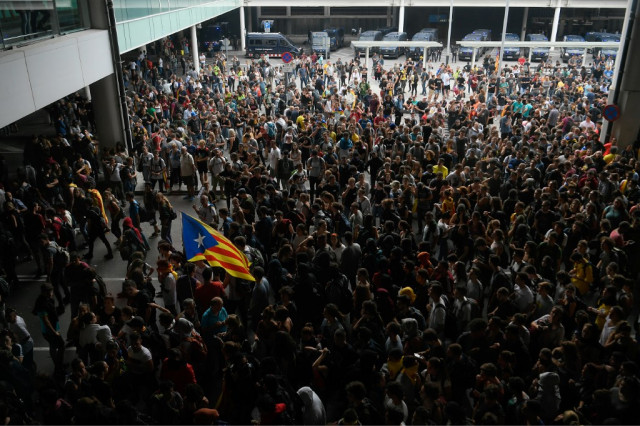 A protester holds a Catalan pro-independence “Estelada” flag surrounded by other protesters at El Prat airport in Barcelona.AFP
A protester holds a Catalan pro-independence “Estelada” flag surrounded by other protesters at El Prat airport in Barcelona.AFP
Barcelona airport right now.
Thousands of people are currently trying to occupy it. pic.twitter.com/ggVvFOsbYE— Catalans for Yes ? (@CatalansForYes) October 14, 2019
? | Protestors sit and whistle the Catalan national anthem in front of police officers in riot gear at the doors of Barcelona airport. “This is our violence,” they also chanted pic.twitter.com/canLie6ojs
— Catalan News (@catalannews) October 14, 2019
Democratic Tsunami, a group advocating more active forms of civil disobedience, had urged demonstrators to hit the streets as soon as the verdicts were announced.
“Tomorrow everyone ready! When the verdict is out, the response will be immediate,” said the group in a message to its roughly 150,000 followers on mobile messaging service Telegram.
Juli Cuellar, a 44-year-old office worker, said he believed the verdict was politically motivated.
“Now all we have left is a life of civil and institutional disobedience,” he told AFP, predicting “weeks of mobilisation”.
The Catalan National Assembly (ANC) and Omnium Cultural, the region's two biggest grassroots pro-independence groups, have also called supporters to attend an evening rally. They have organised some of the largest separatist protests in recent years.
Several more protests are scheduled over the next few days across Catalonia, as well as a general strike on Friday.

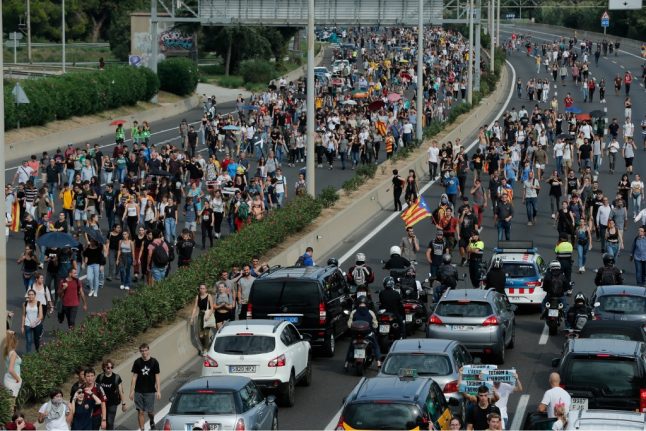
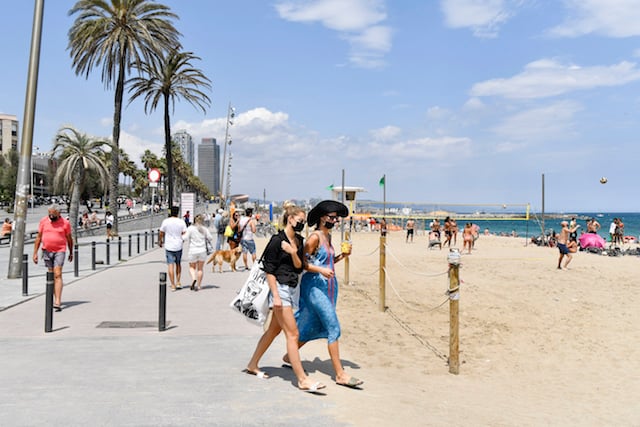

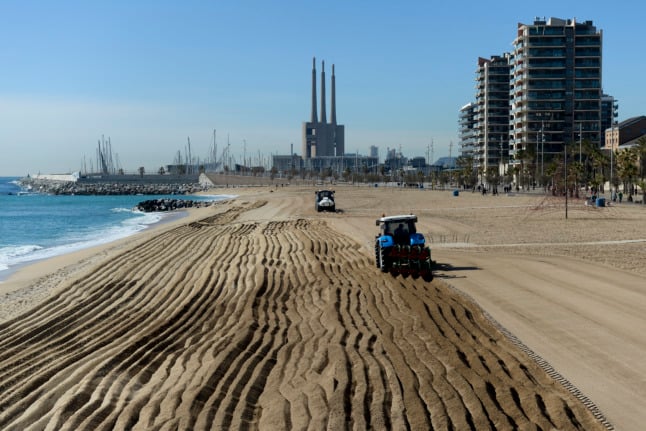
 Please whitelist us to continue reading.
Please whitelist us to continue reading.
Member comments